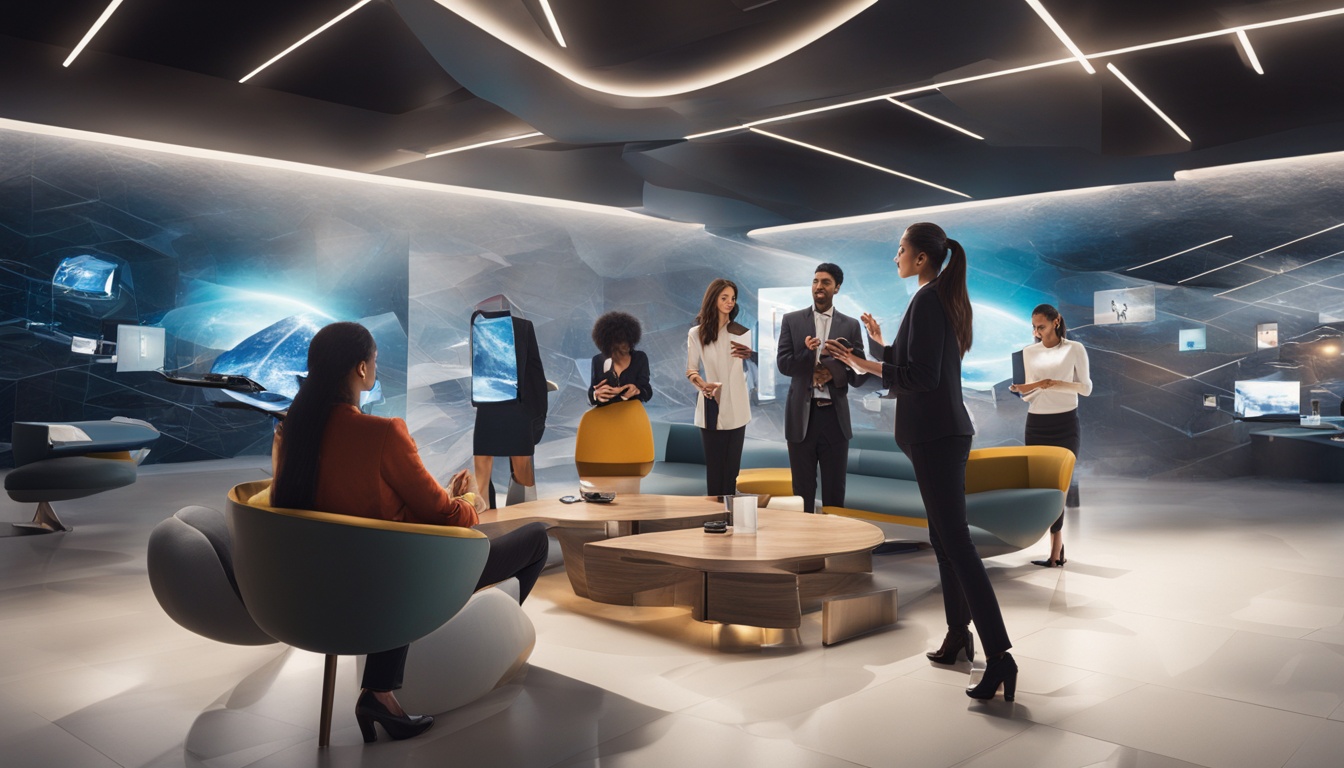Showrooming has become a prevalent retail strategy in recent years, driven by evolving consumer behavior and advancements in technology. It involves visiting brick-and-mortar stores to research products before purchasing them online for a lower price. With the widespread use of smartphones and mobile devices, showrooming has gained traction, benefiting both online retailers and consumers.
For consumers, showrooming provides the opportunity to physically interact with products, allowing them to make more informed purchase decisions. They can test the functionality, quality, and features of the items they’re interested in before committing to a purchase. Additionally, they can compare prices across different online retailers, ensuring that they get the best deal.
On the other hand, online retailers benefit from showrooming by being able to offer competitive prices. They have lower overhead costs compared to brick-and-mortar stores, allowing them to provide attractive discounts and promotions. This makes online shopping more appealing to price-conscious consumers.
To address the challenges presented by showrooming, brick-and-mortar retailers have implemented various strategies. They have enhanced the in-store experience by introducing personalized customer service, interactive displays, and engaging environments. Additionally, many retailers now offer in-store pickup for online purchases and implement price-matching policies to remain competitive.
Overall, showrooming has transformed the retail landscape, blurring the boundaries between online and offline channels. Understanding this strategy and its impact on consumer behavior is essential for retailers to cater to the evolving needs and preferences of their customers.
Key Takeaways:
- Showrooming involves visiting physical stores to research products before purchasing them online for a lower price.
- Consumers benefit from showrooming by being able to test products and compare prices across various online retailers.
- Online retailers benefit from showrooming by offering competitive prices and attracting price-conscious shoppers.
- Brick-and-mortar retailers have responded to showrooming by enhancing the in-store experience and implementing strategies such as in-store pickup and price matching.
- Showrooming has blurred the boundaries between online and offline shopping, necessitating retailers to adapt their strategies to meet changing consumer preferences.
Understanding Showrooming and Its Impact on Retail
Showrooming is a retail phenomenon that has gained significant traction with the widespread use of mobile devices and the exponential growth of e-commerce. It pertains to the practice of visiting physical retail stores to research products and then making the actual purchase online, often from online retailers offering lower prices and free shipping options.
This trend has had a profound impact on both online and brick-and-mortar retailers. Online retailers have leveraged showrooming by capitalizing on their ability to offer competitive prices and provide added convenience through e-commerce. This allows them to attract and retain customers who prefer the convenience of online shopping, driving the growth of their businesses.
On the other hand, this shift in consumer behavior has presented challenges for brick-and-mortar retailers. The prevalence of showrooming has made it crucial for them to adapt their strategies to remain relevant in an increasingly digital landscape. Many physical retailers have responded by implementing in-store pickup options, enhancing the in-store experience, and introducing price-matching policies to compete with online retailers.
In the face of fierce competition from online retailers, brick-and-mortar stores must find ways to differentiate themselves and provide unique value to consumers. A seamless integration of online and offline channels has become imperative for retailers to ensure a cohesive shopping experience for consumers who engage in showrooming. By embracing the growing presence of mobile devices and the convenience they offer, retailers can optimize their strategies to meet the evolving needs of their customers.
In the following table, we outline some key insights regarding the impact of showrooming on both online and brick-and-mortar retailers:
| Online Retailers | Brick-and-Mortar Retailers | |
|---|---|---|
| Benefits | Lower prices, free shipping options | In-store pickup, improved experience, price matching |
| Challenges | Intense competition, potential loss of sales | Competition from online retailers, investment in inventory with potential delayed sales |
| Strategies | Optimize online presence, enhance customer experience, competitive pricing | Improve in-store experience, provide added convenience, match prices |
The Impact of Showrooming on Online Retailers
Online retailers have capitalized on the showrooming trend by offering lower prices compared to brick-and-mortar stores. This strategy allows them to attract customers who are price-sensitive and willing to research products in-store before making a purchase online. Furthermore, the convenience of online shopping and the availability of free shipping options have made online retailers a compelling choice for consumers engaging in showrooming.
The Challenges for Brick-and-Mortar Retailers
Brick-and-mortar retailers face the challenge of intense competition from online retailers who can offer lower prices due to their lower overhead costs. This competition has resulted in a potential loss of sales for physical stores as customers opt for the convenience and cost savings of online shopping. Additionally, brick-and-mortar retailers may invest in inventory and store displays that do not result in immediate sales, as customers choose to make their purchases online instead.
How Showrooming Works and its Benefits for Consumers
Showrooming is a consumer behavior where individuals visit physical retail stores to test products and then make their final purchase online. This practice offers several benefits for consumers, enhancing their shopping experience and ensuring informed decision-making.
One significant advantage of showrooming is the opportunity for product testing. By visiting brick-and-mortar stores, consumers can physically interact with the merchandise, allowing them to assess its quality, functionality, and suitability for their needs. This hands-on experience provides valuable insights that online product descriptions and images cannot fully convey.
In addition to product testing, showrooming enables consumers to compare prices across different online retailers. After evaluating the products in-store, shoppers can conduct price comparisons online, ensuring they obtain the best possible deal. This empowers consumers to make informed and cost-effective purchasing decisions.
Moreover, online retailers often offer additional benefits to incentivize showrooming. These include free shipping, exclusive discounts, and loyalty programs, further enhancing the value proposition for consumers who opt to make their final purchase online. Such perks provide an added layer of convenience and savings for shoppers.
To visualize the benefits of showrooming, consider the following comparison table:
| Benefits | Showrooming | Traditional In-store Shopping |
|---|---|---|
| Product Testing | ✓ | X |
| Price Comparison | ✓ | X |
| Online Retailer Benefits | ✓ | X |
As shown in the table, showrooming offers advantages that traditional in-store shopping lacks. Consumers who engage in showrooming can benefit from product testing, price comparison, and access to exclusive online retailer perks. These benefits contribute to a more informed and cost-conscious shopping experience.
Overall, showrooming empowers consumers by combining the advantages of physical retail stores with the convenience and benefits of online shopping. By leveraging this strategy, shoppers can make confident purchasing decisions while obtaining the best possible value for their budget.
The Challenges of Showrooming for Brick-and-Mortar Retailers
Showrooming presents several challenges for brick-and-mortar retailers. One of the main showrooming challenges that they face is the competition from online retailers. Online retailers often have lower overhead costs, allowing them to offer products at lower prices. This puts physical stores at a disadvantage as customers tend to choose the cheaper options available online, resulting in a loss of sales for brick-and-mortar retailers.
Furthermore, the practice of showrooming can lead to a situation where physical retailers invest heavily in inventory and store displays without seeing immediate returns. Consumers may visit the store to test and inspect products but then choose to make their purchase online, bypassing the physical store altogether. This can be disheartening for retailers, as they put in effort and resources to create an attractive showrooming environment, only to face the challenge of converting those experiences into actual sales.
In order to overcome these challenges, brick-and-mortar retailers must find ways to adapt and compete with online retailers. This can involve implementing strategies such as price matching to provide customers with competitive pricing options. Additionally, retailers can focus on enhancing the in-store experience by offering personalized assistance, interactive displays, and exclusive in-store promotions to create a unique and valuable showrooming experience that cannot be replicated online.
Comparison of Challenges Faced by Brick-and-Mortar Retailers and Online Retailers
| Challenges | Brick-and-Mortar Retailers | Online Retailers |
|---|---|---|
| Competition | Face competition from online retailers offering lower prices due to lower overhead costs. | Face competition from other online retailers, often on a global scale. |
| Loss of Sales | Potential loss of sales as customers choose to purchase products online after showrooming in-store. | Susceptible to cart abandonment and increased competition within the online marketplace. |
| Investment | Invest in inventory and store displays that may not lead to immediate sales. | Require investments in website development and digital marketing strategies. |
By understanding the challenges presented by showrooming and proactively addressing them, brick-and-mortar retailers can continue to thrive in the evolving retail landscape. It is essential for them to stay innovative and find ways to provide value and convenience to customers, while also leveraging their unique strengths as physical retailers.
Strategies for Brick-and-Mortar Retailers to Combat Showrooming
Brick-and-mortar retailers have implemented various strategies to combat the challenges posed by showrooming. These strategies focus on enhancing the in-store experience and providing competitive pricing options to encourage customers to make purchases in-store.
1. Enhance In-Store Experiences
One effective strategy is to provide personalized customer service, interactive displays, and engaging environments. By creating a memorable in-store experience, retailers can differentiate themselves from online retailers and attract customers. Personalized assistance, expert recommendations, and immersive product displays can create a sense of exclusivity and build customer loyalty.
2. Implement Price Matching Policies
To address the competitive pricing factor, brick-and-mortar retailers can implement price-matching policies. This strategy ensures that customers can get the best deal even within a physical store. By offering price matching, retailers demonstrate their commitment to providing competitive prices and eliminate the need for customers to search for better deals online.
3. Create Omnichannel Experiences
By integrating online and offline channels, retailers can create seamless shopping experiences for customers. This involves offering features like online ordering with in-store pickup, allowing customers to enjoy the convenience of online shopping while still benefiting from the in-store experience. Retailers can also use technology to provide personalized recommendations and promotions based on customers’ online and in-store activities.
4. Leverage Customer Data
Brick-and-mortar retailers can collect and analyze customer data to gain insights into purchasing patterns and preferences. By understanding customer behavior, retailers can tailor their in-store experiences and promotional offers to better meet the needs of their customers. Utilizing customer data also enables retailers to provide personalized recommendations and targeted marketing campaigns, enhancing customer satisfaction and loyalty.
5. Foster Brand Loyalty
Building strong relationships with customers is crucial to combat showrooming. Retailers can implement loyalty programs that offer exclusive rewards, discounts, and personalized incentives, encouraging customers to choose their brick-and-mortar store over online retailers. By fostering brand loyalty, retailers can solidify their customer base and reduce the likelihood of showrooming.
| Strategies | Description |
|---|---|
| Enhance In-Store Experiences | By providing personalized customer service, interactive displays, and engaging environments, retailers can differentiate themselves from online retailers and build customer loyalty. |
| Implement Price Matching Policies | Price matching ensures that customers can get the best deal within a physical store, eliminating the need to search for better prices online. |
| Create Omnichannel Experiences | Integrating online and offline channels allows customers to enjoy the convenience of online shopping while still benefiting from in-store experiences. |
| Leverage Customer Data | Analyze customer data to gain insights into purchasing patterns and preferences, enabling personalized recommendations and targeted marketing campaigns. |
| Foster Brand Loyalty | Implement loyalty programs that offer exclusive rewards, discounts, and personalized incentives to encourage customers to choose the brick-and-mortar store over online retailers. |
Webrooming: The Flipside of Showrooming
In the world of retail, consumer behavior has evolved with the advent of e-commerce and the widespread use of mobile devices. While showrooming has gained popularity as consumers research products in-store and make purchases online, an intriguing phenomenon known as webrooming has emerged as its flipside. Webrooming refers to the practice of conducting online research and then finalizing the purchase in a physical store.
Webrooming allows consumers to capitalize on the convenience and extensive product information available online while still benefiting from the tangible experience of interacting with the product before making a purchase. It combines the best of both worlds, enabling shoppers to make informed decisions based on comprehensive online research and then enjoy the sensory experience of physically examining the product.
This trend highlights the importance of integrating online and offline channels to cater to the diverse preferences of consumers. Brands and retailers must recognize the significance of webrooming in shaping consumer behavior and adapt their strategies accordingly to provide a seamless shopping experience that encompasses both digital and physical touchpoints.
The Benefits of Webrooming
Webrooming offers several advantages to consumers:
- Thorough Online Research: Consumers can extensively research product details, specifications, customer reviews, and compare prices across multiple online platforms before making a purchasing decision.
- Convenience: Online platforms provide the convenience of browsing products from the comfort of home or on the go, allowing consumers to familiarize themselves with the available options.
- Offline Interaction: Despite the extensive information available online, webrooming acknowledges the significance of the physical experience. Consumers can visit a store, touch, feel, and try the product firsthand, ensuring it meets their expectations.
- Immediate Gratification: Making the final purchase in a physical store allows consumers to take the product home immediately, avoiding the wait associated with online deliveries.
The Role of Webrooming in Consumer Behavior
Webrooming is driven by various factors related to consumer behavior:
- Trust: Some consumers prefer the security of seeing and experiencing the physical product before making their purchase, as they can inspect the quality, features, and functionality firsthand.
- Shopping Preferences: Certain consumers derive satisfaction from a physical shopping experience, where they can interact with sales associates, ask questions, and seek personalized recommendations.
- Cost Considerations: While online platforms provide competitive prices and discounts, webrooming allows consumers to take advantage of any in-store promotions, discounts, or loyalty programs that may not be available online.
| Comparison of Showrooming and Webrooming | Showrooming | Webrooming |
|---|---|---|
| Research Phase | In-store | Online |
| Purchase Phase | Online | In-store |
| Benefits | – Physical product testing – Price comparison – Convenience of online shopping |
– Thorough online research – Tangible in-store experience – Immediate gratification |
| Consumer Behavior | – Preference for online shopping – Cost savings – Convenience of home delivery |
– Desire for physical interaction – Trust in product quality – Personalized assistance |
By understanding the motivations behind webrooming, retailers can leverage this consumer behavior trend to create a seamless omnichannel experience. Integrating online research with in-store purchase options, personalized assistance, and exclusive in-store promotions can not only attract webrooming consumers but also drive customer loyalty and repeat visits.
Webrooming has become a crucial aspect of the consumer decision-making process. Retailers that acknowledge and adapt to this trend are well-positioned to thrive in the ever-evolving retail landscape.
The Pros and Cons of Showrooming and Webrooming
Showrooming and webrooming are two distinct trends in consumer behavior, each with its own set of advantages and disadvantages for retailers and consumers alike. Understanding the pros and cons of both practices can help retailers tailor their strategies to accommodate the diverse preferences of their customer base.
Showrooming: Pros and Cons
Showrooming offers consumers the opportunity to physically test products in-store before making a purchase decision, providing them with a hands-on experience that online shopping cannot replicate. This allows customers to assess the quality, features, and functionality of a product firsthand, which can lead to more confident buying decisions.
Moreover, showrooming enables consumers to compare prices across different online retailers, ensuring they secure the best possible deal for their desired products. This price-conscious behavior empowers consumers to seek out competitive pricing and potentially save money.
On the flip side, showrooming poses challenges for brick-and-mortar retailers. With customers conducting research in-store and then ultimately making their purchase online, there is a risk of lost sales for physical stores. Additionally, increased competition from online retailers, who often offer lower prices due to lower overhead costs, can further impact the profitability of brick-and-mortar businesses.
Webrooming: Pros and Cons
Webrooming, on the other hand, presents a different set of benefits and drawbacks. Consumers who engage in webrooming can conduct thorough research online, exploring product details, reviews, and comparisons to inform their purchasing decisions. This online research enables customers to make informed choices, potentially leading to higher satisfaction with their purchases.
Furthermore, webrooming offers the convenience of online shopping while still allowing consumers to pick up their desired products at a physical store. This hybrid approach combines the advantages of online and offline channels, providing customers with the best of both worlds.
However, webrooming may result in missed opportunities for online retailers. Consumers who perform extensive research online may ultimately choose to make their purchase in-store, preventing online retailers from capturing these sales. This highlights the need for online retailers to strategically engage with webrooming customers and provide compelling reasons to complete their purchase through their online platforms.
Strategies for Retailers to Embrace Webrooming
To fully embrace webrooming, retailers can implement various strategies that ensure a seamless shopping experience for customers across both online and offline channels. By leveraging these strategies, retailers can effectively cater to the changing preferences of modern consumers and maximize the advantages of webrooming.
1. Seamless Shopping Experience
Creating a seamless shopping experience involves integrating online and offline channels seamlessly, allowing customers to transition effortlessly between the two. Retailers can achieve this by providing a consistent branding and messaging across all touchpoints, including websites, social media platforms, and physical stores. This consistency helps build trust and familiarity with the brand, enhancing the overall customer experience.
2. In-Store Pickup
Offering in-store pickup for online orders is another effective strategy for embracing webrooming. This allows customers to take advantage of online deals and promotions while still having the convenience of physically collecting the product from a nearby store. In-store pickup not only saves customers on shipping costs but also offers the immediacy of getting the product on the same day, providing a distinct advantage over traditional online shopping.
3. Personalized Assistance
Providing personalized assistance in-store is crucial for enhancing the webrooming experience. Retailers can train their staff to offer tailored product recommendations, answer customer queries, and provide expert advice. By offering personalized assistance, retailers can address customer concerns and ensure a superior level of customer service, further encouraging customers to make purchases in-store.
4. Cross-Selling Opportunities
Cross-selling is an effective strategy for retailers to increase sales and encourage customers to explore additional products in-store. By strategically placing related products or accessories near the main product, retailers can entice customers to consider purchasing complementary items. For example, a retailer selling smartphones can display phone cases or screen protectors near the smartphone section, increasing the likelihood of additional purchases.
By adapting these strategies, retailers can successfully embrace webrooming and provide a seamless shopping experience that caters to the evolving needs of customers. The integration of online and offline channels, the convenience of in-store pickup, personalized assistance, and cross-selling opportunities all contribute to a positive customer experience and drive increased sales.
| Advantages | Disadvantages |
|---|---|
| Seamless shopping experience | Requires investment in technology and staff training |
| In-store pickup | Potential inventory management challenges |
| Personalized assistance | Higher labor costs |
| Cross-selling opportunities | Requires careful product placement and planning |
The Future of Showrooming and Webrooming
Showrooming and webrooming are two retail trends that have significantly influenced consumer behavior in recent years. As we look to the future, these trends are expected to continue shaping the way consumers shop and interact with brands. The increasing accessibility of technology and the integration of online and offline channels are driving these changes, giving rise to new opportunities and challenges for retailers. To stay ahead of the curve, businesses must adapt their strategies to cater to evolving consumer preferences and provide a seamless and personalized shopping experience.
The future of showrooming and webrooming lies in harnessing the power of technology to create a more immersive and interactive retail experience. Augmented reality (AR) and virtual reality (VR) technologies have the potential to revolutionize the way consumers interact with products, allowing them to virtually try on clothes, visualize furniture in their homes, or test drive cars without leaving their houses. With the advancement of these technologies, consumers can make more informed purchase decisions and have a better understanding of how products will fit into their lives.
Furthermore, the evolving landscape of consumer behavior calls for an increased focus on personalization. Retailers will need to leverage data and analytics to understand individual preferences and deliver tailored recommendations across online and offline channels. By providing personalized product suggestions, exclusive offers, and customized shopping experiences, retailers can build stronger relationships with customers and enhance brand loyalty.
In addition to personalization, retailers must adapt to changing expectations surrounding convenience and speed. Consumers today desire seamless shopping experiences, where they can seamlessly transition from online research to in-store purchase. Retailers can facilitate this by offering features like buy online, pick up in-store (BOPIS), or same-day delivery options. By blending the advantages of both online and offline shopping, retailers can cater to the needs of modern consumers and provide a truly omnichannel experience.
As the retail landscape continues to evolve, retailers must also anticipate and respond to emerging consumer trends. Sustainability and ethical production have become increasingly important considerations for consumers, and retailers should incorporate these values into their business practices. Embracing eco-friendly initiatives, supporting local communities, and offering transparent supply chains can appeal to socially conscious customers and differentiate brands in a competitive market.
In conclusion, the future of showrooming and webrooming is a dynamic landscape where technology, personalization, convenience, and ethical considerations intersect. By adapting to evolving consumer behavior and leveraging new technologies, retailers can create seamless, immersive shopping experiences that meet the needs and expectations of modern consumers. Embracing these future trends is crucial for retailers to stay competitive, build brand loyalty, and drive long-term success.
Conclusion
Showrooming and webrooming have revolutionized the retail industry, presenting both challenges and opportunities for online and brick-and-mortar retailers. These phenomena have become intrinsic parts of the consumer journey, allowing shoppers to research products online and experience them in-store. By recognizing and embracing these trends, retailers can create a seamless shopping experience that caters to the diverse preferences of modern consumers. Such an approach allows retailers to leverage the strengths of both online and offline channels, fostering stronger customer relationships.
Understanding consumer behavior is crucial for long-term success in today’s rapidly evolving retail landscape. Retailers must adapt their strategies to stay ahead of changing trends. Showrooming and webrooming are powerful indicators of how consumers prefer to engage with brands and make purchase decisions. By embracing these trends and developing innovative retail strategies, companies can meet the evolving needs of their customers and differentiate themselves from competitors.
As showrooming and webrooming continue to shape consumer behavior, success lies in providing a seamless shopping experience across multiple channels. Retailers must capitalize on the convenience and transparency of online research while delivering exceptional in-store experiences. Building strong relationships with customers through personalized assistance and relevant cross-selling opportunities is key. The future of retail requires retailers to continuously innovate and adapt their strategies to meet the ever-changing demands and preferences of their target audience.





